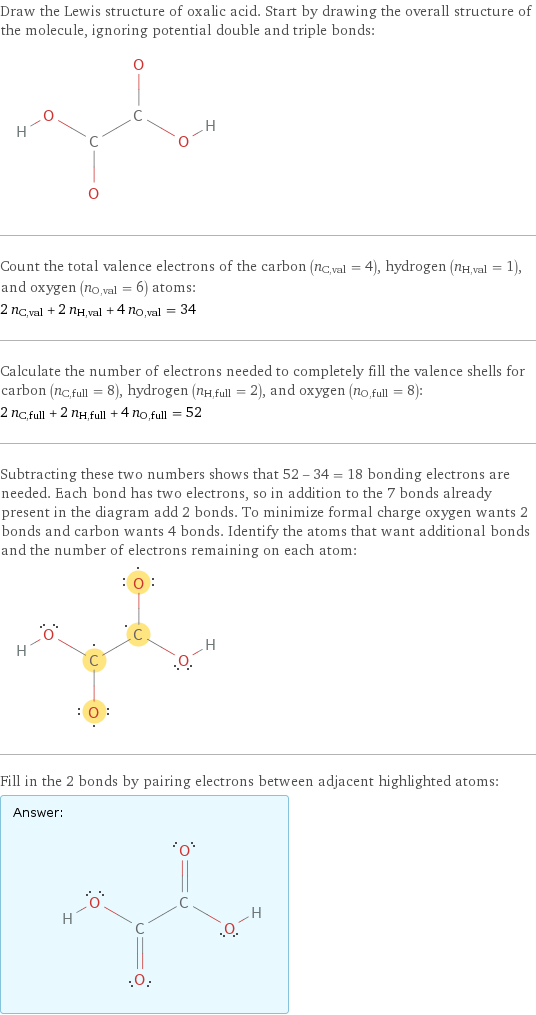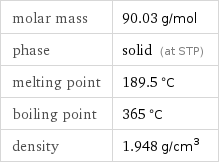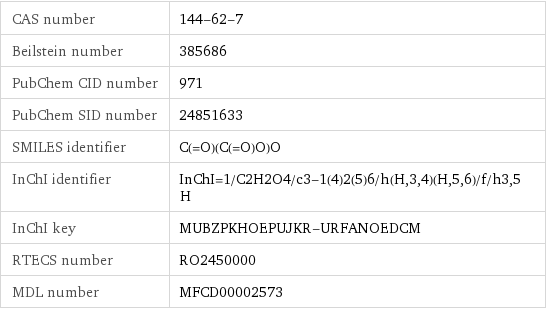Input interpretation

oxalic acid
Chemical names and formulas

formula | HO_2CCO_2H Hill formula | C_2H_2O_4 name | oxalic acid alternate names | aktisal | aquisal | ethanedioic acid | ethanedionic acid mass fractions | C (carbon) 26.7% | H (hydrogen) 2.24% | O (oxygen) 71.1%
Lewis structure

Draw the Lewis structure of oxalic acid. Start by drawing the overall structure of the molecule, ignoring potential double and triple bonds: Count the total valence electrons of the carbon (n_C, val = 4), hydrogen (n_H, val = 1), and oxygen (n_O, val = 6) atoms: 2 n_C, val + 2 n_H, val + 4 n_O, val = 34 Calculate the number of electrons needed to completely fill the valence shells for carbon (n_C, full = 8), hydrogen (n_H, full = 2), and oxygen (n_O, full = 8): 2 n_C, full + 2 n_H, full + 4 n_O, full = 52 Subtracting these two numbers shows that 52 - 34 = 18 bonding electrons are needed. Each bond has two electrons, so in addition to the 7 bonds already present in the diagram add 2 bonds. To minimize formal charge oxygen wants 2 bonds and carbon wants 4 bonds. Identify the atoms that want additional bonds and the number of electrons remaining on each atom: Fill in the 2 bonds by pairing electrons between adjacent highlighted atoms: Answer: | |
3D structure

3D structure
Basic properties

molar mass | 90.03 g/mol phase | solid (at STP) melting point | 189.5 °C boiling point | 365 °C density | 1.948 g/cm^3
Units

Hydrophobicity and permeability properties

predicted LogP hydrophobicity | -0.5 experimental LogS | 0.38 predicted LogS | -0.14
Basic drug properties

approval status | experimental | small molecule drug categories | reducing agent
Solid properties (at STP)

density | 1.948 g/cm^3 vapor pressure | 0.009998 mmHg
Units

Thermodynamic properties

specific heat capacity c_p | gas | 0.9574 J/(g K) | solid | 1.011 J/(g K) molar heat capacity c_p | gas | 86.2 J/(mol K) | solid | 91 J/(mol K) specific free energy of formation Δ_fG° | gas | -7.361 kJ/g molar free energy of formation Δ_fG° | gas | -662.7 kJ/mol specific heat of formation Δ_fH° | gas | -8.128 kJ/g | solid | -9.218 kJ/g molar heat of formation Δ_fH° | gas | -731.8 kJ/mol | solid | -829.9 kJ/mol molar heat of vaporization | 67.2 kJ/mol | specific heat of vaporization | 0.746 kJ/g | molar heat of combustion | 245.6 kJ/mol | specific heat of combustion | 2.728 kJ/g | (at STP)
Chemical identifiers

CAS number | 144-62-7 Beilstein number | 385686 PubChem CID number | 971 PubChem SID number | 24851633 SMILES identifier | C(=O)(C(=O)O)O InChI identifier | InChI=1/C2H2O4/c3-1(4)2(5)6/h(H, 3, 4)(H, 5, 6)/f/h3, 5H InChI key | MUBZPKHOEPUJKR-URFANOEDCM RTECS number | RO2450000 MDL number | MFCD00002573
NFPA label

NFPA label

NFPA health rating | 3 NFPA fire rating | 1 NFPA reactivity rating | 0
Safety properties

flash point | 189 °C lower explosive limit | 8.5% (concentration in air) upper explosive limit | 28% (concentration in air)

DOT hazard class | 8 DOT numbers | 3261
Toxicity properties

lethal dosage | 375 mg/kg (oral dose for rats) short-term exposure limit | 2 mg/m^3

probable lethal dose for man | 30 mL (milliliters) long-term exposure limit | 1 mg/m^3 (over 8 hours) RTECS classes | reproductive effector | human data | primary irritant